A Boon To Cancer Detection Method: LED Lights Could Be Used For Tumour Detection
We are all aware of the most prominent light sources that help us to accomplish our daily tasks. All life on earth would cease, had it not been for the suns' light. Besides, the sun, a host of artificial sources including incandescent lamps, LEDs and laser sources are pivotal to 21st century life. Light has been a subject of constant research and finding new applications have been instrumental to scientific advancement.
According to a recent research press release from "Nanoscale", an interdisciplinary team from Rice university have confirmed on the basis of thorough experimentation, that mere LED lights have an enormous potential to identify tumours, by shining the light on them. Such a conclusion was drawn using an instrument based approach, dubbed as "spectral triangulation system", which is a customized version of the modern medical imaging system.
According to a recent research press release from "Nanoscale", an interdisciplinary team from Rice university have confirmed on the basis of thorough experimentation, that mere LED lights have an enormous potential to identify tumours, by shining the light on them. Such a conclusion was drawn using an instrument based approach, dubbed as "spectral triangulation system", which is a customized version of the modern medical imaging system.

The Rice University Research Team
Team leader Bruce Weisman along with his group placed detection of carbon-nanotube marker tagged, antibody associated tumour cells as their main objective. As an explanation, they said that the absorption coefficient of short wave infrared light in tissues feature different wavelengths at different levels. Owing to such a phenomena, light-spectra analysis was preferred as it could produce information related to the depth of tissues, through which light has passed.
The process mentioned above was the one to initialise the task. The next work up was to determine 3D carbon nanotubes. Carbon nanotubes behave as fluorescent markers when treated with short-wave infrared wavelengths and are stimulated via light. With the help of a powerful tool, InGaAs Avalanche Photodiode, minute signals from nanotubes ranging up to 20mm (in terms of Depth) could be determined.
The process mentioned above was the one to initialise the task. The next work up was to determine 3D carbon nanotubes. Carbon nanotubes behave as fluorescent markers when treated with short-wave infrared wavelengths and are stimulated via light. With the help of a powerful tool, InGaAs Avalanche Photodiode, minute signals from nanotubes ranging up to 20mm (in terms of Depth) could be determined.
Weisman commented that for the very first time, an extremely complicated light detector was used to confirm the amount of localised emission by a constricted area having immense applications in medical science. Here the photodiode played a key role to detect and count emitted photons. The team mentioned that as a trigger, LED lights are very uncommon and LASER is prevalent everywhere. However, due to the scattering phenomena, it lacks affinity to focus inside tissues, whereas LED’s are a much more viable option in this regard.

Target locked: Complete Instrumental set up to get the x,y,z location of Carbon Nano-tubes
Talking about the setup, an optical probe is held with a 3D printer frame and is held above the specimen. As soon as the probe gets close enough to the target skin, a computer program helps to analyse the readings at grid points. Light emanating from the carbon nanotubes get lost inside water before reaching the detector and that's where Weisman's Spectral Triangulation comes into the scene.
A 2D search method could only give information about X and Y directly, with the depth remaining unknown. To aid the system, the team used Spectral Triangulation method which brings the Carbon Nano tube assembly closer to the skin if the short and long wavelengths have similar emission intensity, as water has greater affinity to absorb a longer wavelength. However, if the emission source is placed deeper, then the water would favour longer wavelengths than the shorter ones.
The instrument is currently under the second stage of review. Ultimately, this could turn out to be the next instrument that diagnostic centres will turn in order to non-invasively produce accurate results regarding tumors.The research was supported and funded by National Science Foundation, the Welch Foundation, the National Institutes of Health and the John S. Dunn Foundation Collaborative Research Award Program.
A 2D search method could only give information about X and Y directly, with the depth remaining unknown. To aid the system, the team used Spectral Triangulation method which brings the Carbon Nano tube assembly closer to the skin if the short and long wavelengths have similar emission intensity, as water has greater affinity to absorb a longer wavelength. However, if the emission source is placed deeper, then the water would favour longer wavelengths than the shorter ones.
The instrument is currently under the second stage of review. Ultimately, this could turn out to be the next instrument that diagnostic centres will turn in order to non-invasively produce accurate results regarding tumors.The research was supported and funded by National Science Foundation, the Welch Foundation, the National Institutes of Health and the John S. Dunn Foundation Collaborative Research Award Program.
Source: <a href="https://pubs.rsc.org/en/Content/ArticleLanding/2016/NR/C6NR01376G#!divAbstract" target="_blank" rel="nofollow noopener noreferrer">Spectral triangulation: a 3D method for locating single-walled carbon nanotubes in vivo - Nanoscale (RSC Publishing)</a>
0
